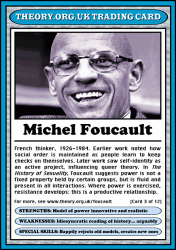
Fashioning the Body: Versions of the Citizen, the Self, and the Subject
The Evergreen State College | Fall 2007-Winter 2008
User Login |
Resources
FOUCAULT RESOURCES 1. Foucault interviewed by Lucette Finas [thanks to Mykey], from Power/Knowledge: Selected Interviews and Other Writings, 1972-1977 2. Foucault Dictionary [thanks to Melanie]: http://www.california.com/~rathbone/foucau10.htm 3. A Page on Foucault's notion of "power/knowledge" [Thanks to Amanda]: http://www.colostate.edu/Depts/Speech/rccs/theory54.htm 4. "Welcome to the World of Foucault" (essays, links, etc.) http://www.csun.edu/~hfspc002/foucault.home.html 5.theory.org.uk is a fantastic, thorough resource on the work of Foucault, among other influential contemporary philosophers and critical theorists (including Judith Butler, covered week 4). The FOUCAULT pages there contain a boatload of material to supplement our work on his History of Sexuality, an Introduction, Vol. 1. He's even gotten his very own trading card. Poke around the site to find the others.
INTELLECTUAL HISTORY/CONTEXT of FOUCAULT, MAUSS, and DOUGLAS: Though we know Wikipedia isn't the last word on everything, I would like to offer it to you as perhaps a first word on something, namely the Structuralist and Post-structuralist schools of thought. Foucault was a Structuralist and then became a Post-structuralist, and Mauss and Douglas were Structuralists. This bit of intellectual context will nicely inform your work on these authors' writings, we think. STRUCTURALISM (according to Wikipedia) POST-STRUCTURALISM (ditto)
TERESA DE LAURETIS RESOURCES: Semiotics for Beginners page. Teresa de Lauretis comes out of film theory and semiotics. Her use of the terms "sign" and "semiotic apparatus" may require some context.
JUDITH BUTLER RESOURCES: 1. Good interview from 1993: http://www.theory.org.uk/but-int1.htm 2. Theory.org.uk Butler resource site (links to the interview above): http://www.theory.org.uk/ctr-butl.htm
ON "ABJECT" "ABJECTION" and "THE ABJECT" use Wikip. to start: http://en.wikipedia.org/wiki/Abjection and this discussion of "the abject" in the book In the Flesh the Cultural Politics of Body Modification, Victoria Pitts-Taylor
VARIOUS 19th Century + 19th c. Photography LINKS: (Marey was mentioned in Julia's wk 1 lecture) "Étienne Jules Marey was a scientist, as Marta Braun has put it in her biography, not an artist or entertainer. Marey recorded series of chronophotographies in order to analyze sequences of movements...What do we see [here], then? A "cinematic physiology" of shaking hands, or simply hand-shaking physiologists? The sequence is bound to some peculiar recursiveness. It shows experts for animal movement in movement and – thanks to our digital animation – the physiological emergence of motion pictures as pictures in motion. No one else than Marey indicates this loop. After having shaken hands with Mosso, he turns around behind him. His eyes seem to look in our direction – addressing the spectators. But in reality, Marey is watching his assistant besides the camera. The experimenter monitors his apparatus." 2. Francis Galton (eugenicist, composite photography) 3. The Virtual Laboratory: Essays on the Experimentalization of Life 4. Arthur Elsenaar + Remko Scha, "Electric Body Manipulation as Performance Art: A Historical Perspective," Leonardo Music Journal, Vol. 12 (2002) pp. 17–28. Fascinating article covering the history of electricity and the body, including Guillaume Duchenne (who we touched on in week 3)
BRECHT RESOURCES: For those of you with the energy to tackle some more theory, here is an article on feminist readings of Brecht that I'll pirate from Tuesday Wk 6, "Brecht and the Mothers of Epic Theater," by Iris Smith. And here are some links you may want to check out for basic information on Brechtian theory: http://www.dur.ac.uk/m.p.thompson/brecht.htm http://oregonstate.edu/instruct/ger342/brechtet.htm http://www.salisbury.edu/theatre/Epic%20Theatre/Epic%20theatre.htm Brecht's FBI File, courtesy of your Freedom of Information Act
CYBORG/AUTOMATA RESOURCES: 1. Donna Haraway, "A Cyborg Manifesto: Science, Technology, and Socialist-Feminism in the Late Twentieth Century," in Simians, Cyborgs and Women: The Reinvention of Nature (New York; Routledge, 1991), pp.149-181. 2. A brief discussion of Haraway's "Cyborg Manifesto" 3. Links and more links to various cyborg-related sites, essays and discussions from the University of Iowa Communication Studies Department 4. Freud's essay, "The Uncanny" in which he performs a literary (psycho-)analysis of E.T.A. Hoffman's short tale, "The Sand-man." 5. A la Bornstein, I suppose, here is "The Cyborg Workbook" by Rebecca White.
WEEK 2 GYMNASIUM LINKS 1. Guillermo Gomez Pena's website Pocha Nostra 2. Gomez Pena/Sifuentes/Luna photo series that Elizabeth showed in Wk 2 Gymnasium: http://www.zachgrossphotography.com/pochanostra/
WEEK 3 GYMNASIUM LINKS: 1. Dear Friends: American Photographs of Men Together, 1840-1918. Exhbition at The International Center for Photography (ICP), New York, March-June 2001. 2. Mirrors: An Exbition of Photographs Found and Printed by Bruce Jackson. Nina Freudenheim Gallery, Buffalo, NY, Sept-Oct 2004. 3. Most Wanted Men by Andy Warhol (1964) Warhol's Most Wanted Men series was based on mug shots published by the New York Police Department in 1962. To translate the photographs into paintings, Warhol used silkscreening. 4. Historical U.S. Census Forms and archival photos and artifacts @ The U.S. Census Bureau Website
WEEK 4 REVUE LINKS:
Gallery of some of Opie's work Interview with Opie
Submitted by admin on Tue, 01/02/2007 - 2:42pm. printer friendly version
|
Who's onlineThere are currently 0 users and 1 guest online.
Events
|
|||||||||||||||||||||||||||||||||||||||||||||||||

